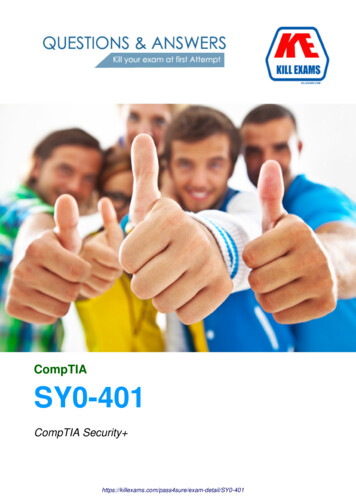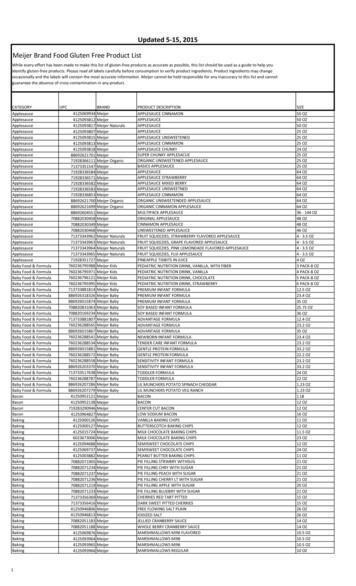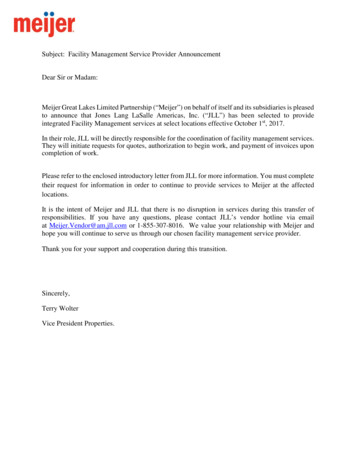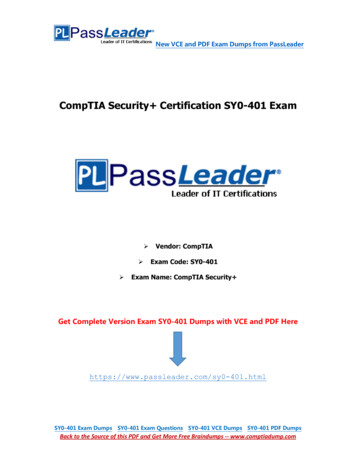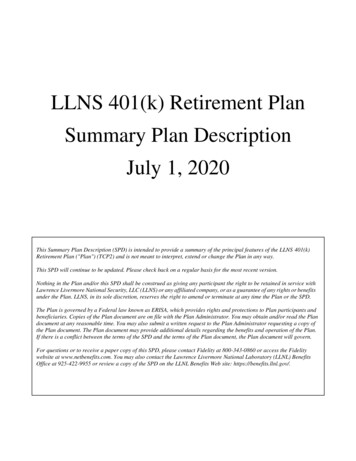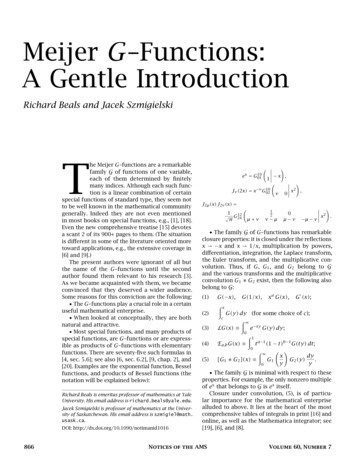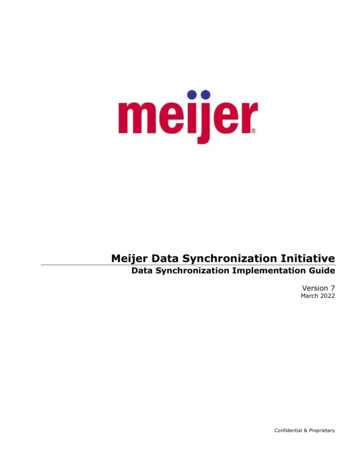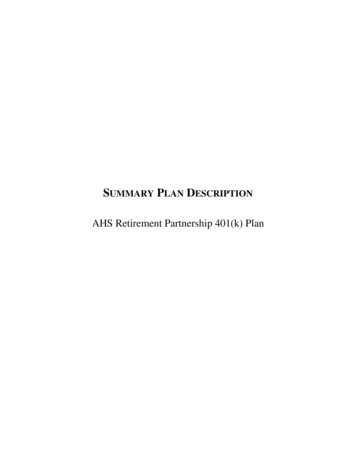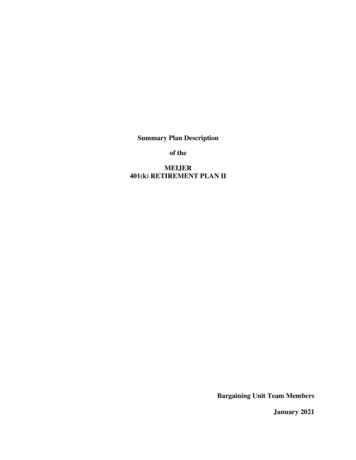
Transcription
Summary Plan Descriptionof theMEIJER401(k) RETIREMENT PLAN IIBargaining Unit Team MembersJanuary 2021
TO OUR TEAM MEMBERSMeijer, Meijer Stores Limited Partnership and Meijer Great Lakes Limited Partnership(together called “Meijer”) maintain the Meijer 401(k) Retirement Plan II so that you and otherteam members may save for retirement on a “tax-favored” basis.This document is called a “Summary Plan Description.” Its purpose is to explain your rightsunder the Plan. It is based upon the Plan provisions in effect on January 1, 2021. You shouldcarefully read this Summary Plan Description and keep it for future reference.This Summary Plan Description applies to both “grandfathered” and “nongrandfathered”Bargaining Unit team members. The terms “grandfathered” and “nongrandfathered” are definedon page 2 of this Summary Plan Description.The primary difference between the two groups of team members is that “grandfathered” teammembers generally earned their Meijer retirement benefit under a Meijer Pension Plan before theMeijer Pension Plans were “frozen.” “Nongrandfathered” team members generally earn theirMeijer retirement benefit in a Meijer 401(k) Plan. The Summary Plan Description providesspecific information about the different provisions under the Plan that apply to “grandfathered”and “nongrandfathered” team members.You are responsible for decisions affecting your participation in the Plan. These decisionsinclude the amount of your contributions and the manner in which your accounts will beinvested. No one can make these decisions for you. Because these decisions will affect theamount of your retirement benefits, you should carefully review this Summary PlanDescription.This Summary Plan Description has been prepared as accurately as possible. It outlines the Plan,which is a complex and technical legal document. In the event of any difference between theSummary Plan Description and the Plan, the terms of the Plan will control.
TABLE OF CONTENTSPageOVERVIEW OF THE PLAN .1DEFINITION OF “GRANDFATHERED” TEAM MEMBER .2DEFINITION OF “NONGRANDFATHERED” TEAM MEMBER .2OTHER KEY DEFINITIONS TO ASSIST YOUR UNDERSTANDING OF THE PLAN .3HOW TO BECOME A PARTICIPANT IN THE PLAN .5Salary Deferral Contributions .5Matching and Base Contributions .5Transition Company Contributions .5SALARY DEFERRAL CONTRIBUTIONS .6How to Make Salary Deferral Contributions .6Pre-Tax or After-Tax Salary Deferrals .6Crediting of Your Salary Deferrals .6Benefits of Deferring Compensation Under the Plan .6Dollar Limit on Salary Deferrals .7MATCHING CONTRIBUTIONS .8Amount of Matching Contributions .8True-Up Matching Contribution .8BASE CONTRIBUTIONS.9TRANSITION COMPANY CONTRIBUTIONS .10ROLLOVERS .11VESTED INTEREST IN YOUR ACCOUNTS .11Vesting Rules .11Year of Vested Service .12Forfeited Amounts .13INVESTMENT OF YOUR ACCOUNTS .13VALUATION AND ADJUSTMENT OF YOUR ACCOUNTS.14Contributions .14Distributions .14Investment Results .14-i-
PageWHEN BENEFITS ARE DISTRIBUTED .14WITHDRAWALS AFTER YOU REACH AGE 59½ .15FINANCIAL HARDSHIP WITHDRAWALS .15Reasons for Hardship Withdrawals .15Additional Requirements for Hardship Withdrawals .16Amount of Your Hardship Withdrawal .16Tax on Hardship Withdrawal .16WITHDRAWAL FROM ROLLOVER ACCOUNT .16DISABILITY WITHDRAWALS .17DISTRIBUTION OF BENEFITS UPON TERMINATION OF EMPLOYMENT .17FORM OF DISTRIBUTION OF BENEFITS .17Exception if Vested Amount is 5,000 or Less .18DISTRIBUTION OF BENEFITS UPON DEATH .18Designation of Beneficiary .18Special Rule if You are Married.18Death Before Benefit Payments Begin .18Death After Benefit Payments Begin .19Tax on Distribution .19OTHER RULES THAT APPLY TO THE CASH-OUT OF SMALL BENEFITS .19TAX RULES ON DISTRIBUTIONS .20Income Tax on All Distributions – General Rules .20Excise Tax on Certain Early Distributions .20Distributions from Your Roth 401(k) Account – Special Rules .20Other Rollover Rules .21LOANS FROM THE PLAN .22TRANSFERRED TEAM MEMBERS.23APPEAL PROCEDURE .24LEGAL ACTIONS.24QUALIFIED MILITARY SERVICE .25Withdrawals While Performing Qualified Military Service .25Differential Wage Payments .25-ii-
PageRights After Reemployment .25Loans from the Plan .25Death During Qualified Military Service .26ASSIGNMENT OF BENEFITS/QUALIFIED DOMESTIC RELATIONS ORDER .26General Rule .26Exception for QDROs .26BENEFITS ARE NOT INSURED .27ADMINISTRATION .27AMENDMENT OR TERMINATION OF THE PLAN .27YOUR RIGHTS AS A PARTICIPANT .27Plan Information and Benefits .27Plan Fiduciaries .28Enforcement of Rights.28Assistance with Your Questions.29OTHER BASIC INFORMATION ABOUT YOUR 401(k) RETIREMENT PLAN .30EXHIBIT A .31-iii-
OVERVIEW OF THE PLANThe Plan is a type of retirement plan known as a “401(k)” plan. The following types ofcontributions may be made to the Plan: You may contribute part of your current compensation instead of receiving it inyour paychecks. These contributions are called “salary deferral contributions.”Your salary deferral contributions may be made on either a pre-tax or after-taxbasis, as explained in the “SALARY DEFERRAL CONTRIBUTIONS” section. Meijer may make matching contributions for you based upon the amount of yoursalary deferral contributions to the Plan. Meijer may make a base contribution for each plan year. If you are a “grandfathered” team member, Meijer may also make “transitioncompany contributions” for certain plan years.Your salary deferrals and the Meijer contributions (if any) made for you are credited to accountsin your name. Any amounts you roll over to the Plan from another retirement plan are alsocredited to an account in your name (see the “ROLLOVERS” section below). Your accounts areinvested together with the other participants’ accounts in certain investment funds. The amountin your accounts will change in value based upon the increase or decrease in value of theinvestment funds in which your accounts are invested.Your benefits from the Plan are the vested amounts in your accounts. When you leave Meijerand become eligible for benefit payments, you will receive payments in the form you chooseuntil you receive the full amount owed to you from your accounts. The vested amount in youraccounts will depend on the amount of your salary deferrals, the amount of Meijer contributions(if any) made on your behalf, your investment results, and your years of service with Meijer.You will not be taxed on the contributions to the Plan (other than your Roth 401(k)contributions), or on the investment earnings credited to your accounts, until these amounts areactually distributed to you from your accounts. You can further delay taxes by rolling over yourdistribution to a traditional IRA or another employer’s eligible retirement plan. Earnings on yourRoth 401(k) contributions will not be subject to income taxes if you satisfy certain distributionrequirements. See the “TAX RULES ON DISTRIBUTIONS” section for more information,including special rules that apply to distributions from your Roth 401(k) account.Alight is the recordkeeper for the Plan and provides various administrative services. Tochange your elections under the Plan, use the Plan website at https://digital.alight.com/meijeror contact the Meijer Rewards Service Center at 1-866-681-6116.All correspondence regarding the Plan is sent to your address on file at the Meijer RewardsService Center. So, if you move and change your address, it is very important that you providethe new address:
If you are employed by Meijer, you should change your address in Workday. If you are no longer employed by Meijer, you should change your address onthe Plan website or by calling the Meijer Rewards Service Center.Further, as previously indicated, you have access to your account through the Plan website orby calling the Meijer Rewards Service Center. Your password is used to gain access.Because the use of your password is your signature for all Plan-related transactions, youshould keep your password confidential. If you change or reset your password, you shouldverify that your address on file at the Meijer Rewards Service Center is current so that anyconfirmation of the change is mailed to the current address.DEFINITION OF “GRANDFATHERED” TEAM MEMBERYou are a “grandfathered” team member if you satisfy all of the following requirements: You were employed by Meijer on December 31, 2011. As of December 31, 2011, you satisfied at least one of the following: You were age 40 or older and had ten or more years of vested serviceunder a Meijer Pension Plan; or You had 20 or more years of vested service under a Meijer Pension Plan,regardless of your age.You have not terminated employment with Meijer after December 31, 2011.You may contact the Meijer Rewards Service Center if you have any questions regardingwhether you are a “grandfathered” team member.DEFINITION OF “NONGRANDFATHERED” TEAM MEMBERYou are a “nongrandfathered” team member if any of the following apply to you: You were employed by Meijer on December 31, 2011, but you failed to satisfythe requirements described above to be “grandfathered.” You were a “grandfathered” team member as of December 31, 2011, but youterminated employment with Meijer after December 31, 2011. You were hired or rehired by Meijer after December 31, 2011.You may contact the Meijer Rewards Service Center if you have any questions regardingwhether you are a “nongrandfathered” team member.-2-
OTHER KEY DEFINITIONS TO ASSIST YOUR UNDERSTANDING OF THE PLANThe Plan uses a number of terms to describe your rights and benefits. Here are some of the moreimportant terms: “Accounts” means the bookkeeping accounts which are used to record yourbenefits under the Plan. You have separate accounts for various types ofcontributions. You may have some or all of the following accounts: A salary deferral account, which is used to record your pre-tax salarydeferral contributions. A Roth 401(k) account, which is used to record your after-tax salarydeferral contributions. A pre-2012 matching contribution account, which is used to recordmatching contributions made for you before the 2012 plan year. A matching contribution account, which is used to record the matchingcontributions made for you beginning with the 2012 plan year (or the planyear you became eligible, if later). A pre-2012 discretionary base contribution account, which is used torecord discretionary base contributions made for you before the 2012 planyear. A pre-2017 base company contribution account, which is used to recordthe base contributions made for you beginning with the 2013 plan year (orthe plan year you became eligible if later) and ending with the 2016 planyear. A post-2016 base company contribution account, which is used to recordthe base contributions made for you beginning with the 2017 plan year (orthe plan year you became eligible, if later). If you are an eligible“grandfathered” team member, your transition company contributions willalso be credited to this account. A rollover account, which is used to record the pre-tax amounts you rolledover from another employer’s eligible retirement plan or a traditional IRA. A Roth rollover account, which is used to record the Roth amounts yourolled over from another employer’s retirement plan.Your accounts are adjusted for investment gains and losses.-3-
“Compensation” means amounts paid to you through Meijer’s payroll system thatare subject to federal income tax withholding. This includes regular pay,overtime pay, and bonuses. However, the following special rules apply: Your salary deferral contributions under the Plan are counted. Your pay reduction contributions under a flexible benefits plan maintainedby Meijer are counted. Any “differential wage payment” made to you while you are in qualifiedmilitary service is counted. For each type of contribution, amounts paid before you became eligiblefor that type of contribution are not counted. Amounts earned while working in an ineligible job classification are notcounted. Reimbursements, expense allowances and fringe benefits are not counted. Pay for unused supplemental days is not counted. Severance pay is not counted.“Highly compensated team member” means, for any plan year, a team memberwho satisfies one of the following requirements: Is at least a 5% owner of Meijer; or Had at least 130,000 in compensation during the prior plan year. (The 130,000 amount is periodically adjusted for inflation.) “Plan year” is the fiscal year of the Plan, which is January 1 throughDecember 31. All records of the Plan are based upon payroll weeks for whichpayment is made during the plan year. “Salary deferrals” are contributions to the Plan that you make from yourcompensation. These contributions are generally made on a pre-tax basis and aresometimes called “401(k) contributions.” You may choose to make thesecontributions on an after-tax basis. The after-tax salary deferrals are called “Roth401(k) contributions.” “Vesting schedule accounts” are your accounts under the Plan that are subject to avesting schedule. See the “VESTED INTEREST IN YOUR ACCOUNTS”section for more information.-4-
HOW TO BECOME A PARTICIPANT IN THE PLANThis Plan covers all bargaining unit team members.The Plan also covers team members who work in a new store in Kentucky, Michigan, or Ohio ina job that is traditionally covered by a collective bargaining agreement between Meijer and aunion. However, if you work in a traditional bargaining unit job and do not join a bargainingunit by October 1 of the year following the year in which the store opened, you will becomeeligible to participate in the Meijer 401(k) Retirement Plan I and will no longer participate in thisPlan. If this rule applies to you, your accounts will be transferred to the Meijer 401(k)Retirement Plan I as soon as administratively feasible.If you are an eligible team member, here is when you will become a participant in the varioustypes of contributions:Salary Deferral ContributionsYou become a participant for salary deferral contributions on your date of employmentwith Meijer.To begin making salary deferral contributions, you must enroll and should designate abeneficiary. Meijer Rewards automatically sends enrollment information to newlyeligible team members. You may enroll online at the Plan website or you may call theMeijer Rewards Service Center.Matching and Base ContributionsYou become a participant for matching and base contributions on the first Sunday afteryou complete 12 months of employment with Meijer. If you are a “grandfathered” teammember, you became eligible to participate in matching contributions as of January 1,2018 and you became eligible to participate in base contributions as of March 1, 2020.Transition Company ContributionsOnly “grandfathered” team members are eligible for transition company contributions.“Grandfathered” team members became eligible to participate in transition companycontributions on March 1, 2020.If you leave Meijer after becoming a participant and are later reemployed, you are eligible toparticipate again as of your date of reemployment to the same extent you were participatingbefore you terminated employment. However, if you are a “grandfathered” team member andyour employment terminates, you will lose your “grandfathered” status.-5-
SALARY DEFERRAL CONTRIBUTIONSHow to Make Salary Deferral ContributionsYou elect the amount of your salary deferrals when you enroll. There are limits on howmuch you may contribute: Your salary deferrals may not exceed 75% of your compensation duringany pay period. Your total salary deferrals during a calendar year under this Plan and anyother 401(k) plan or 403(b) plan in which you participate also may notexceed the dollar limit described in the “Dollar Limit on Salary Deferrals”subsection below. If you are a highly compensated team member, certain rules in the InternalRevenue Code may limit how much you may contribute.You may stop salary deferrals, or change your salary deferral percentage, at any timeon the Plan website at https://digital.alight.com/meijer or by contacting the MeijerRewards Service Center at 1-866-681-6116.Pre-Tax or After-Tax Salary DeferralsYou may choose whether to make your salary deferral contributions on a pre-tax basis, anafter-tax basis (called “Roth 401(k) contributions”), or a combination of both. You mustmake your decision before the salary deferral contributions are made.Your decision will affect your current income tax liability and the tax status ofdistributions of your salary deferrals from the Plan. See the “Benefits of DeferringCompensation Under the Plan” subsection below and the “TAX RULES ONDISTRIBUTIONS” section for more information.You should consult your tax adviser to determine which type of salary deferralcontribution is likely to be better for you.Your salary deferrals do not affect other Meijer-provided benefits that are based upon theamount of your compensation (for example, life insurance or weekly short-term disabilitybenefits). They will continue to be based on your unreduced pay.Crediting of Your Salary DeferralsYour pre-tax salary deferrals are credited to your “salary deferral account.” Your Roth401(k) contributions are credited to your “Roth 401(k) account.”Benefits of Deferring Compensation Under the PlanThe benefits of deferring compensation under the Plan are as follows:-6-
Any amounts contributed to the Plan as a result of your pre-tax salarydeferral election are not subject to current income taxes. As a result, yourcurrent taxable income will be reduced and you will pay less in incometaxes. Your Roth 401(k) contributions will not be subject to income taxes at thetime of distribution. As a result, your future taxable income will bereduced. You may be eligible for a tax credit of between 10% and 50% of yourcontribution if your adjusted gross income is no more than 66,000 (if youare married filing jointly) or 33,000 (if you are unmarried or marriedfiling separately). The maximum contribution eligible for the credit is 2,000 ( 4,000 if married filing jointly). Here are some resources thatmay help you determine if you are eligible for the credit and the amount ofthe credit: the IRS website (www.irs.gov), the IRS tax help line(1-800-829-1040), or a professional tax adviser. The amount contributed to the Plan is generally invested on a tax-deferredbasis. This means you will not pay income tax on the investment earningsthat are added to your accounts. You will pay income taxes only whenyou receive your benefits from the Plan. As a result, this tax deferralpermits a much more rapid accumulation of funds for your retirement. A qualified distribution from your Roth 401(k) account is not taxable. Seethe “TAX RULES ON DISTRIBUTIONS” section for more information. Meijer will make a matching contribution based upon the amount of yoursalary deferrals. See the “MATCHING CONTRIBUTIONS” section formore information.Dollar Limit on Salary DeferralsFederal law limits the amount of your salary deferrals in a calendar year. For 2021, theannual dollar limit is 19,500. The dollar limit applies to pre-tax salary deferralcontributions and Roth 401(k) contributions on a combined basis. This amount isadjusted periodically for inflation.In addition, if you are at least age 50 by the end of a calendar year, you are also allowedto make “catch-up” salary deferral contributions during the calendar year. For 2021, thedollar limit for the “catch-up” salary deferral contributions is 6,500. This amount is alsoadjusted periodically for inflation.Therefore, if you are at least age 50 by the end of 2021, you may make salary deferralcontributions in an amount up to 26,000 ( 19,500 6,500) during 2021. Again, thisamount may be increased after 2021 for increases in the cost of living.-7-
If your salary deferrals exceed the dollar limit for a calendar year, the “excess deferrals”must be included in your taxable income for the year of the deferral. The excess amountwill also be taxed again in the year it is distributed to you if it is not withdrawn byApril 15 of the following year. To receive a distribution before April 15, your request fordistribution must be made by March 1.Meijer will attempt to prevent your salary deferral contributions to the Plan fromexceeding the dollar limit. However, if you also participate in another tax-deferredsavings plan sponsored by another employer (such as another 401(k) plan or a 403(b)plan), the dollar limit applies to your total salary deferral contributions to these plans.You will need to monitor the total contributions if you make salary deferral contributionsto more than one plan. This could occur, for example, in the first calendar year that youparticipate in the Plan.Also, as indicated earlier, if you are a highly compensated team member, certain rules inthe Internal Revenue Code may limit how much you may contribute. If your salarydeferrals exceed the highly compensated limit for a calendar year, the “excesscontributions” will be distributed and included in your taxable income for the year ofdistribution, which will be the year following the year of the deferral.MATCHING CONTRIBUTIONSMeijer will make matching contributions each pay period based upon the amount of your salarydeferrals after you become a participant in the matching contribution portion of the Plan.Amount of Matching ContributionsAfter you become eligible for matching contributions, Meijer will contribute 40 for each 1 of your salary deferrals. But no matching contributions will be made with regard tosalary deferral contributions that exceed 5% of your compensation for a pay period.Therefore, the maximum matching contribution is 2% of your compensation during anypay period.True-Up Matching ContributionMeijer will make a “true-up” matching contribution at the end of the plan year in limitedcircumstances. This additional contribution will be generally made if your salarydeferrals are more than 5% of your compensation in some pay periods, but less than 5%of your compensation in other pay periods. The additional matching contribution will,when added to the matching contributions already made for you, put you in the samesituation as if the matching contribution was calculated based upon your total salarydeferrals and compensation for the plan year (that is, 40% of your salary deferrals for theplan year to the extent your salary deferrals do not exceed 5% of your compensationduring the plan year).-8-
Further, you are only eligible for a “true-up” matching contribution for a plan year if yousatisfy one of the following requirements: You are employed by Meijer on the Wednesday immediately before thedate of the last paycheck issued during the plan year; You terminate employment with Meijer during the plan year as a result ofyour retirement after reaching age 65 and after satisfying one of thefollowing: You have completed five years of participation in the Plan; or You have completed five years of continuous service with Meijer.You terminate employment with Meijer during the plan year as a result ofyour death.A special calculation rule applies to the true-up matching contribution during the firstplan year that you are eligible for matching contributions. The true-up is only based uponyour compensation and salary deferral contributions after you become eligible to receivematching contributions. However, if you are a “grandfathered” team mem
Meijer, Meijer Stores Limited Partnership and Meijer Great Lakes Limited Partnership (together called "Meijer") maintain the Meijer 401(k) Retirement Plan II so that you and other team members may save for retirement on a "tax-favored" basis. This document is called a "Summary Plan Description." Its purpose is to explain your rights
